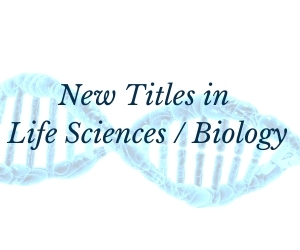System Upgrade on Tue, May 28th, 2024 at 2am (EDT)
Existing users will be able to log into the site and access content. However, E-commerce and registration of new users may not be available for up to 12 hours.For online purchase, please visit us again. Contact us at customercare@wspc.com for any enquiries.
This is a book of an international series on interdisciplinary topics of the Mathematical and Biological Sciences. The chapters are related to selected papers on the research themes presented at BIOMAT 2015 International Symposium on Mathematical and Computational Biology which was held in the Roorkee Institute of Technology, in Roorkee, Uttarakhand, India, on November 02–06, 2015. The treatment is both pedagogical and advanced in order to motivate research students to fulfill the requirements of professional practitioners. As in other volumes of this series, there are new important results on the interdisciplinary fields of mathematical and biological sciences and comprehensive reviews written by prominent scientific leaders of famous research groups.
There are new results based on the state of art research in Population Dynamics, on Pattern Recognition of Biological Phenomena, the Mathematical Modelling of Infectious Diseases, Computational Biology, the Dynamic and Geometric Modelling of Biological Phenomena, the Modelling of Physiological Disorders, the Optimal Control Techniques in Mathematical Modelling of Biological Phenomena, the Hydrodynamics and Elasticity of Cell Tissues and Bacterial Growth and the Mathematical Morphology of Biological Structures. All these contributions are also strongly recommended to professionals from other scientific areas aiming to work on these interdisciplinary fields.
Sample Chapter(s)
Network Structure and Enzymatic Evolution in Leishmania Metabolism: A Computational Study (713 KB)
Contents:
- Mathematical Modelling of Infectious Diseases:
- Network Structure and Enzymatic Evolution in Leishmania Metabolism: A Computational Study (A Subramanian & R R Sarkar)
- Long-Term Potential of Imperfect Seasonal Flu Vaccine in Presence of Natural Immunity (S Ghosh & J M Heffernan)
- Impact of Non-Markovian Recovery on Network Epidemics (G Röst, Z Vizi & I Z Kiss)
- A Modelling Framework for Serotype Replacement in Vaccine-Preventable Diseases (M Kang, A L Espindola, M Laskowski & S M Moghadas)
- Pattern Recognition of Biological Phenomena:
- An Integrative Approach for Model Driven Computation of Treatments in Reproductive Medicine (R Ehrig, T Dierkes, S Schäfer, S Röblitz, E Tronci, T Mancini, I Salvo, V Alimguzhin, F Mari, I Melatti, A Massini, B Leeners, T H C Krüger, M Egli, F Ille & B Leeners)
- The Network Route to Biological Complexity (S J Banerjee, R K Grewal, S Sinha & S Roy)
- A Systems Biology Approach to Bovine Fertility and Metabolism: Introduction of a Glucose Insulin Model (Julia Plöntzke, M Berg, C Stötzel & S Röblitz)
- Biographer: Visualization of Graph Theoretical Patterns, Measurements, and Analysis in Mathematical Biology (R Viswanathan, S Liang, Y Yang & J R Jungck)
- Hydrodynamics and Elasticity of Cell Tissues and Bacterial Growth:
- Modelling the Early Growth of Stem Cell Tissues (R A Barrio, S Orozco-Fuentes & R Romero-Arias)
- Non-local Hydrodynamics of Swimming Bacteria and Self-Activated Process (S Roy & R Llinás)
- Dynamic and Geometric Modelling of Biomolecular Structures:
- Geometric Analysis of the Conformational features of Protein Structures (M Datt)
- Computational Biology:
- Prediction of System States, Robustness and Stability of the Human Wnt Signal Transduction Pathway using Boolean Logic (L Nayak, R K De & A Datta)
- Entropy Measures and the Statistical Analysis of Protein Family Classification (R P Mondaini & S C de Albuquerque Neto)
- Clustering Neuraminidase Influenza Protein Sequences (X Li, H Jankowski, S Boonpatcharanon, V Tran, X Wang & J M Heffernan)
- Optimal Control Techniques in Mathematical Modelling of Biological Phenomena:
- Optimal Control for Therapeutic Drug Treatment on a Delayed Model Incorporating Immune Response (P Dubey, B Dubey & U S Dubey)
- Population Dynamics:
- Bifurcations and Oscilllatory Dynamics in a Tumor Immune Interaction Model (S Khajanchi)
- On a Nonlinear System Modelling Darwinian Dynamics and the Immune Response to Cancer Evolution (A Bellouquid, M Ch-Chaoui & E de Angelis)
- Sexual Selection is Not Required: A Mathematical Model of Species with Sexually Differentiated Death Rates (D Wallace, E Dauson, C Pinion & K Hayashi)
- Models for Two Strains of the Caprine Arthritis Encephalitis Virus Disease (S Collino, E Venturino, L Ferreri, L Bertolotti, S Rosati & M Giacobini)
- Conservation of Forestry Biomass Introducing Variable Taxation for Harvesting: A Mathematical Model (M Chaudhary, J Dhar & O P Misra)
- Stability Analysis of a Two Species Competition Model with Fuzzy Initial Conditions: Fuzzy Differential Equation Approach Environment (S Paul, P Bhattacharya & K S Chaudhuri)
- Modelling Physiological Disorders:
- Magnetic Resonance Guided High Intensity Focused Ultrasound — Mathematical Modeling of an Innovative, State of the Art Technology for Cancer Therapy (J Murley, J Thangaraj, J Drake, A Waspe & S Sivaloganathan)
- The Effects of Fibroblasts on Wave Dynamics in a Mathematical Model for Human Ventricular Tissue (A R Nayak & R Pandit)
- A Simple Logistic Sigmoidal Model Predicts Oxidative Stress Thresholds in Newly Diagnosed Diabetics on Glucose Control Therapy (R Kulkarni)
Readership: Undergraduates, graduates, researchers and all practitioners in the interdisciplinary fields of Mathematical Biology, Biological Physics and Mathematical Modelling of Biosystems.
























